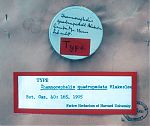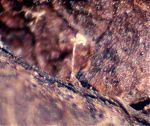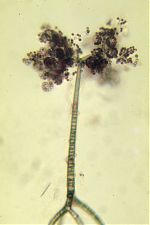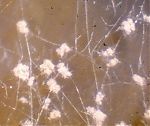Thamnocephalis
THAMNOCEPHALIS Blakeslee, 1905 [Botanical Gazette (Crawfordsville) 40: 165]; 3 species (Benny et al., 1992—monograph and KEY; Blakeslee, 1905—ILLUS; B.S. Mehrotra and B.R. Mehrotra, 1964)
Sporulating heads more or less globose, stalked; fertile hyphae coenocytic initially, septate when mature, composed of coiled hyphae that bifurcate, one branch becoming a sterile spine, all sterile spine apices free, and the other continuing to grow; at each branching point, except the last 1 or 2, two stalks are produced each bearing a globose fertile vesicle covered with spores. Merosporangia globose to obovoid, unispored, ornamented, pedicellate. Zygospores unknown. A haustorial parasite.
Type species: T. quadrupedata
Species of Thamnocephalis:
T. ovalispora B.S. Mehrotra & B.R. Mehrotra, 1964 (Zentralbl. Bakteriol. Hyg., II Abt., 117:425) (B.S. Mehrotra and B.R. Mehrotra, 1964; Mirza et al., 1979).
= Chaetocladium ovalisporum (B.S. Mehrotra & B.R. Mehrotra) Mil’ko & Beljakova, 1974 (in Mil’ko, Opredelitel’-mukoral’nykh gribov, p. 233)
T. quadrupedata Blakeslee, 1905 [Botanical Gazette (Crawfordsville) 40:165] (Benny et al., 1992; Blakeslee, 1905; Chien, 1992, 1998, 2000—host is Basidiobolus ranarum; O’Donnell, 1979; Ou, 1940).
= Chaetocladium quadrupedata (Blakeslee) Mil’ko & Beljakova, 1974 (in Mil’ko, Opredelitel’-mukoral’nykh gribov, p. 233)
T. sphaerospora R.K. Benjamin & Benny, 1992 (Mycologia
84:622) (Benny et al., 1992).
Thamnocephalis produces its sporulating head on a stalk and it differs from Reticulocephalis and Sigmoideomyces which are sessile. Three species of Thamnocephalis are recognized (Benny et al., 1992). Thamnocephalis ovalispora is known only from India and Pakistan (Mehrotra and Mehrotra, 1964; Mirza et al., 1979), T. quadrupedata from the northeastern United States, the Peoples Republic of China, and Taiwan (Blakeslee, 1905; Ou, 1940; Chien, 1992, 1998, 2000), and T. sphaerospora from Texas, United States (Benny et al., 1992).
The majority of the collections of Thamnocephalis were made from dung (Benny et al., 1992). Thamnocephalis quadrupedata and T. sphaerospora have been isolated from frog dung (Benny et al., 1992; Chien, 1992, 1998, 2000). Chien (2000) demonstrated that T. quadrupedata is a haustorial parasite of Basidiobolus ranarum. Another species of Thamnocephalis, T. sphaerospora, has been grown in culture using both Cokeromyces recurvatus (Mucoraceae, Mucorales) and Microascus duguetii (Ascomycetes) as hosts (Benny et al., 1992). A molecular phylogenetic study that included Thamnocephalis sphaerospora showed that it belonged in the Zoopagales (Tanabe et al., 2000). Members of the Zoopagales are also described as being haustorial mycoparasites (Benjamin, 1979; Chien, 2000).
Bibliography
Benjamin, R.K. 1979. Zygomycetes and their spores, pp. 573-616. In: B. Kendrick (Ed.). The whole fungus: the sexual-asexual synthesis. Vol. 2. National Museums of Canada, Ottawa, Canada.
Benny, G.L., R.K. Benjamin, and P. M. Kirk. 1992. A reevaluation of Cunninghamellaceae (Mucorales). Sigmoideomycetaceae fam. nov. and Reticulocephalis gen. nov.; cladistic analysis and description of two new species. Mycologia 84: 615-641.
Blakeslee, A. F. 1905. Two conidia-bearing fungi. Cunninghamella and Thamnocephalis n. gen. Botanical Gazette (Crawfordsville) 40: 161-170.
Chien, C.-Y. 1992. Mycological training and education in Taiwan. Transaction of the Mycological Society of Japan 33:111-116.
Chien, C.-Y. 1998. Thamnocephalis quadrupedata as a mycoparasite on cultures of frog fungus. Sixth International Mycological Congress Abstracts, IMC6, Jerulsalem, Isreal. P. 110
Chien, C.-Y. 2000. Thamnocephalis quadrupedata (Mucorales) as a mycoparasite of the entomophthoraceous fungus Basidiobolus ranarum. Cytobios 103:71-78.
Mehrotra, B.S., and B.R. Mehrotra. 1964. Thamnocephalis – refound. Zentralbl. Bakteriol. Hyg., II Abt., 117:425-428.
Mirza, J. H., S. M. Khan, S. Begum, and S. Shagufta. 1979. Mucorales of Pakistan. University of Agriculture, Faisalabad, Pakistan. 183 p.
O’Donnell, K.L. 1979. Zygomycetes in culture. Palfrey Contributions in Botany. No. 2. Department of Botany, University of Georgia, Athens, Georgia. 257 p.
Ou, S.H. 1940. Phycomycetes of China II. Sinensia 11:427-449.
Tanabe, Y., K. O’Donnell, M. Saikawa, and J. Sugiyama. 2000. Molecular phylogeny of parasitic Zygomycota (Dimargaritales, Zoopagales) based on nuclear small subunit ribosomal DNA sequences. Molecular Phylogenetics and Evolution 16:253-262.
Updated Apr 09, 2007





